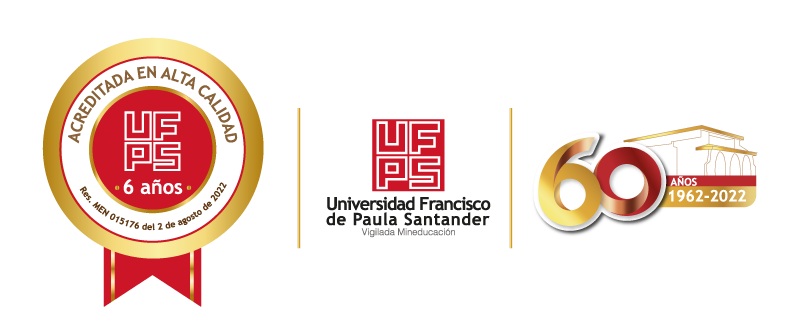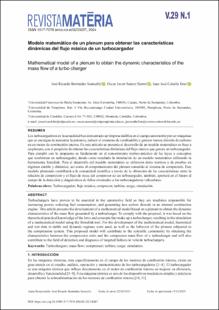Modelo matemático de un plenum para obtener las características dinámicas del flujo másico de un turbocargador
Mathematical model of a plenum to obtain the dynamic characteristics of the mass flow of a turbo-charger
| dc.contributor.author | Bermudez Santaella, Jose Ricardo | |
| dc.contributor.author | Suarez, Oscar J. | |
| dc.contributor.author | Cabello Eras, Juan José | |
| dc.date.accessioned | 2024-04-09T14:50:57Z | |
| dc.date.available | 2024-04-09T14:50:57Z | |
| dc.date.issued | 2023-12-15 | |
| dc.identifier.uri | https://repositorio.ufps.edu.co/handle/ufps/6862 | |
| dc.description.abstract | Los turbocargadores en la actualidad han demostrado ser imprescindibles en el campo automotriz por ser máquinas que se encargan de aumentar la potencia, reducir el consumo de combustible y generar menos dióxido de carbono en un motor de combustión interna. En este artículo se presenta el desarrollo de un modelo matemático en base a un plenum, con el propósito de obtener las características dinámicas del flujo másico que genera un turbocargador. Para cumplir con lo propuesto se fundamentó en el conocimiento teórico-práctico de las leyes y conceptos que conforman un turbocargador, dando como resultado la simulación de un modelo matemático utilizando la herramienta Simulink. Para el desarrollo del modelo matemático se utilizaron datos teóricos y de pruebas en régimen estable y dinámico, así como el comportamiento del plenum sometido al sistema de compresión. Este modelo planteado contribuirá a la comunidad científica a través de la obtención de las características entre la relación de compresión y el flujo de masa del compresor de un turbocargador, también, aportará en el futuro al campo de la detección y diagnósticos de fallos orientados a los turbocargadores vehiculares. | spa |
| dc.description.abstract | Turbochargers have proven to be essential in the automotive field as they are machines responsible for increasing power, reducing fuel consumption, and generating less carbon dioxide in an internal combustion engine. This article presents the development of a mathematical model based on a plenum to obtain the dynamic characteristics of the mass flow generated by a turbocharger. To comply with the proposal, it was based on the theoretical-practical knowledge of the laws and concepts that make up a turbocharger, resulting in the simulation of a mathematical model using the Simulink tool. For the development of the mathematical model, theoretical and test data in stable and dynamic regimes were used, as well as the behavior of the plenum subjected to the compression system. This proposed model will contribute to the scientific community by obtaining the characteristics between the compression ratio and the compressor mass flow of a turbocharger and will also contribute to the field of detection and diagnosis of targeted failures in vehicle turbochargers. | eng |
| dc.format.extent | 20 Páginas | spa |
| dc.format.mimetype | application/pdf | spa |
| dc.language.iso | eng | spa |
| dc.publisher | Revista Materia | spa |
| dc.relation.ispartof | Matéria (Rio J.) 29 (1) 2024. https://doi.org/10.1590/1517-7076-RMAT-2023-0267 | |
| dc.rights | This is an Open Access article distributed under the terms of the Creative Commons Attribution License | eng |
| dc.rights.uri | https://creativecommons.org/licenses/by/4.0/ | spa |
| dc.source | https://www.scielo.br/j/rmat/a/brv5MTfnPhpyvndVGvLWr5v/?lang=es | spa |
| dc.title | Modelo matemático de un plenum para obtener las características dinámicas del flujo másico de un turbocargador | spa |
| dc.title | Mathematical model of a plenum to obtain the dynamic characteristics of the mass flow of a turbo-charger | eng |
| dc.type | Artículo de revista | spa |
| dcterms.references | NAVE, O., “A semi-analytical method applied to turbocharger engine model”, Journal of Applied Research and Technology, v. 18, n. 4, pp. 178–186, 2020. doi: http://dx.doi.org/10.22201/icat.24486736e.2020.18.4.1193. » https://doi.org/10.22201/icat.24486736e.2020.18.4.1193 | spa |
| dcterms.references | PLOTNIKOV, L., ZHILKIN, B., BRODOV, M., “Management of thermal and mechanic flow characteristics in the output channels of a turbocharger centrifugal compressor”, Journal of Physics: Conference Series, v. 1369, n. 1, pp. 012002, 2019. doi: http://dx.doi.org/10.1088/1742-6596/1369/1/012002. » https://doi.org/10.1088/1742-6596/1369/1/012002 | spa |
| dcterms.references | ARNOLD, S., “Single sequential turbocharger: A new boosting concept for ultra-low emission diesel engines”, SAE International Journal of Engines, v. 1, n. 1, pp. 232–239, 2009. doi: http://dx.doi.org/10.4271/2008-01-0298. » https://doi.org/10.4271/2008-01-0298 | spa |
| dcterms.references | MUQEEM, M., AHMAD, M., SHERWANI, A., “Turbocharging of diesel engine for improving performance and exhaust emissions: a review”, Journal of Mechanical and Civil Engineering, v. 12, n. 4, pp. 22–29, 2015. doi: http://dx.doi.org/10.9790/1684-12432229. » https://doi.org/10.9790/1684-12432229 | spa |
| dcterms.references | LUO, Q., HU, J.-B., SUN, B., et al, “Effect of equivalence ratios on the power, combustion stability and NOx controlling strategy for the turbocharged hydrogen engine at low engine speeds”, International Journal of Hydrogen Energy, v. 44, n. 31, pp. 17095–17102, 2019. doi: http://dx.doi.org/10.1016/j.ijhydene.2019.03.245. » https://doi.org/10.1016/j.ijhydene.2019.03.245 | spa |
| dcterms.references | PLAKSIN, A., GRITSENKO, A., GLEMBA, K., “Modernization of the turbocharger lubrication system of an internal combustion engine”, Procedia Engineering, v. 129, pp. 857–862, 2015. doi: http://dx.doi.org/10.1016/j.proeng.2015.12.122. » https://doi.org/10.1016/j.proeng.2015.12.122 | spa |
| dcterms.references | PIANCASTELLI, L., FRIZZIERO, L., “Turbocharging and turbocompounding optimization in automotive racing”, Journal of Engineering and Applied Sciences, v. 9, n. 11, pp. 2192–2199, 2014. | spa |
| dcterms.references | FU, J., LIU, J., WANG, Y., et al, “A comparative study on various turbocharging approaches based on IC engine exhaust gas energy recovery”, Applied Energy, v. 113, pp. 248–257, 2014. doi: http://dx.doi.org/10.1016/j.apenergy.2013.07.023. » https://doi.org/10.1016/j.apenergy.2013.07.023 | spa |
| dcterms.references | ZAMBONI, G., CAPOBIANCO, M., “Experimental study on the effects of HP and LP EGR in an automotive turbocharged diesel engine”, Applied Energy, v. 94, pp. 117–128, 2012. doi: http://dx.doi.org/10.1016/j.apenergy.2012.01.046. » https://doi.org/10.1016/j.apenergy.2012.01.046 | spa |
| dcterms.references | GAO, W., LI, T., TANG, Z., et al, “Investigation on the comparative life cycle assessment between newly manufacturing and remanufacturing turbochargers”, Procedia CIRP, v. 61, pp. 750–755, 2017. doi: http://dx.doi.org/10.1016/j.procir.2016.11.214. » https://doi.org/10.1016/j.procir.2016.11.214 | spa |
| dcterms.references | WU, B., HAN, Z., YU, X., et al, “A method for matching two-stage turbocharger system and its influence on engine performance”, Journal of Engineering for Gas Turbines and Power, v. 141, n. 5, pp. 18, 2018. doi: http://dx.doi.org/10.11151/1.4039461. » https://doi.org/10.11151/1.4039461 | spa |
| dcterms.references | BABEL, M., KOSSOV, B., “Model of exhaust system of a traction diesel engine with pulse supercharging on transient modes”, Combustion Engines, v. 168, n. 1, pp. 38–45, 2017. doi: http://dx.doi.org/10.19206/CE-2017-106. » https://doi.org/10.19206/CE-2017-106 | spa |
| dcterms.references | WANG, J., SHEN, L., BI, Y., et al, “Influences of a variable nozzle turbocharger on the combustion and emissions of a light-duty diesel engine at different altitudes”, Fuel, v. 349, pp. 128626, 2023. doi: http://dx.doi.org/10.1016/j.fuel.2023.128626. » https://doi.org/10.1016/j.fuel.2023.128626 | spa |
| dcterms.references | MEDICA, V., Simulation of turbocharged diesel engine driving electrical generator under dynamic working conditions, Rijeka, University of Rijeka, 1988. | spa |
| dcterms.references | MOUSAVI, S., NEJAT, A., ALAVIYOUN, S., et al, “An Integrated turbocharger matching program for internal combustion engines”, Journal of Applied Fluid Mechanics, v. 14, n. 4, pp. 1209–1222, 2021. doi: http://dx.doi.org/10.47176/jafm.14.04.32037. » https://doi.org/10.47176/jafm.14.04.32037 | spa |
| dcterms.references | TSIAKMAKIS, S., FONTARAS, G., ANAGNOSTOPOULOS, K., et al, “A simulation based approach for quantifying CO2 emissions of light duty vehicle fleets: a case study on WLTP introduction”, Transportation Research Procedia, v. 25, pp. 3898–3908, 2017. doi: http://dx.doi.org/10.1016/j.trpro.2017.05.308. » https://doi.org/10.1016/j.trpro.2017.05.308 | spa |
| dcterms.references | MANSOURI, H., OMMI, F., “Performance prediction of aircraft gasoline turbocharged engine at high-altitudes”, Applied Thermal Engineering, v. 156, pp. 587–596, 2019. doi: http://dx.doi.org/10.1016/j.applthermaleng.2019.04.116. » https://doi.org/10.1016/j.applthermaleng.2019.04.116 | spa |
| dcterms.references | WOJCIECHOWSKI, H., ZÓLTOWSKI, B., “Exploitation of car turbochargers - selected problems”, MATEC Web Conference, v. 302, pp. 01024, 2019. doi: http://dx.doi.org/10.1051/matecconf/201930201024. » https://doi.org/10.1051/matecconf/201930201024 | spa |
| dcterms.references | HEDAU, G., RAJ, R., SAHA, S., “Effect of outlet plenum design on flow boiling heat transfer in microchannel heat sinks”, Journal of Sound and Vibration, v. 139, pp. 2020, 2023. | spa |
| dcterms.references | DEHNER, R., SELAMET, A., “Physics of deep surge in an automotive turbocharger centrifugal compression system”, Journal of Engineering for Gas Turbines and Power, v. 141, n. 6, pp. 061003, 2019. doi: http://dx.doi.org/10.1115/1.4042303. » https://doi.org/10.1115/1.4042303 | spa |
| dcterms.references | ANDREARCZYK, A., “Flow characteristics of an automotive compressor with an additively manufactured rotor disc”, Archives of Thermodynamics, v. 42, n. 1, pp. 3–13, 2023. doi: http://dx.doi.org/10.24425/ather.2021.136944. » https://doi.org/10.24425/ather.2021.136944 | spa |
| dcterms.references | MCMULLEN, R., PINO, Y., “Conditioning turbocharger compressor map data for use in engine performance simulation”, SAE International Journal of Engines, v. 11, n. 4, pp. 491–507, 2018. doi: http://dx.doi.org/10.4271/03-11-04-0033. » https://doi.org/10.4271/03-11-04-0033 | spa |
| dcterms.references | SHEORAN, Y., BOULDIN, B., HOOVER, R., et al, “A centrifugal compressor operability correlation with combined total pressure and swirl distortion”, Proceedings of the ASME Turbo Expo, v. 1, pp. 1–11, 2017. doi: http://dx.doi.org/10.1115/GT2017-63721. » https://doi.org/10.1115/GT2017-63721 | spa |
| dcterms.references | GRAPOW, F., LISKIEWICZ, G., “Compressor modeling using greitzer model validated by pressure oscillations”, Transition of the Institute of Fluid-Flow Machinery, v. 133, pp. 69–89, 2016. | spa |
| dcterms.references | GRAVDAHL, J., EGELAND, O., “Speed and surge control for a low order centrifugal compressor model”, Modeling, Identification and Control, v. 19, n. 1, pp. 13–29, 1998. doi: http://dx.doi.org/10.4173/mic.1998.1.2. » https://doi.org/10.4173/mic.1998.1.2 | spa |
| dcterms.references | HANSEN, K., JORGENSEN, P., LARSEN, P., “Experimental and theoretical study of surge in a small centrifugal compressor”, Journal of Fluids Engineering, v. 103, n. 3, pp. 391–395, 1981. doi: http://dx.doi.org/10.1115/1.3240796. » https://doi.org/10.1115/1.3240796 | spa |
| dcterms.references | HOLDEN, T., “Modeling and control of a wet-gas centrifugal compressor “, IEEE Transactions on Control Systems Technology, v. 29, n. 3, pp. 1175–1190, 2021. doi: http://dx.doi.org/10.1109/TCST.2020.2993224. » https://doi.org/10.1109/TCST.2020.2993224 | spa |
| dcterms.references | SERRANO, J., ARNAU, F., DOLZ, V., et al, “A model of turbocharger radial turbines appropriate to be used in zero- and one-dimensional gas dynamics codes for internal combustion engines modelling”, Energy Conversion and Management, v. 49, n. 12, pp. 3729–3745, 2008. doi: http://dx.doi.org/10.1016/j.enconman.2008.06.031. » https://doi.org/10.1016/j.enconman.2008.06.031 | spa |
| dcterms.references | ZHENG, X., SUN, Z., KAWAKUBO, T., et al, “Experimental investigation of surge and stall in a turbocharger centrifugal compressor with a vaned diffuser”, Experimental Thermal and Fluid Science, v. 82, pp. 493–506, 2017. doi: http://dx.doi.org/10.1016/j.expthermflusci.2016.11.036. » https://doi.org/10.1016/j.expthermflusci.2016.11.036 | spa |
| dcterms.references | ANDERSSON, P., Air charge estimation in turbocharged spark ignition engines, Linköping, Linköpings Universitet, 2005. | spa |
| dcterms.references | VAN HELVOIRT, J. “Centrifugal compressor surge: modeling and identification for control”, Eindhoven: Technische Universiteit Eindhoven, 2007. doi: http://dx.doi.org/10.6100/IR629084 » https://doi.org/10.6100/IR629084 | spa |
| dcterms.references | FANG, X., CHEN, W., ZHOU, Z., et al, “Empirical models for efficiency and mass flow rate of centrifugal compressors”, International Journal of Refrigeration, v. 41, pp. 190–199, 2014. doi: http://dx.doi.org/10.1016/j.ijrefrig.2014.03.005. » https://doi.org/10.1016/j.ijrefrig.2014.03.005 | spa |
| dcterms.references | VENSON, G., BARROS, J. “Turbocharger performance maps building using a hot gas test stand”, in Proceedings of the ASME Turbo Expo, 2008, pp. 777–785. doi: http://dx.doi.org/10.1115/GT2008-50994. » https://doi.org/10.1115/GT2008-50994 | spa |
| dcterms.references | ARGOLINI, R., BLOISI, V., “On optimal control of the wastegate in a turbocharged SI engine”, M.Sc. Thesis, KTH Royal Institute of Technology, Stockholm, Sweden, 2007. | spa |
| dcterms.references | GRAVDAHL, J., EGELAND, O., VATLAND, S., “Active surge control of centrifugal compressors using drive torque”, In: Proceedings of the IEEE Conference on Decision and Control, vol. 2, pp. 1286–1291, Dec. 2001. doi: http://dx.doi.org/10.1109/CDC.2001.981067 » https://doi.org/10.1109/CDC.2001.981067 | spa |
| dcterms.references | TORREGROSA, A., BROATCH, A., MARGOT, X., et al, “Local flow measurements in a turbocharger compressor inlet”, Experimental Thermal and Fluid Science, v. 88, pp. 542–553, 2017. doi: http://dx.doi.org/10.1016/j.expthermflusci.2017.07.007. » https://doi.org/10.1016/j.expthermflusci.2017.07.007 | spa |
| dcterms.references | GRONG, T., “Modeling of compressor characterisics and active surge control”, M.Sc. Thesis, Norwegian University of Science and Technology, Trondheim, pp. 1–97, 2009, http://hdl.handle.net/11250/259909, accessed in December, 2023. » http://hdl.handle.net/11250/259909 | spa |
| dcterms.references | LEUFVÉN, O., Compressor modeling for control of automotive two stage turbochargers, Linköping, Linköpings Universitet, 2010. | spa |
| dcterms.references | ROMAGNOLI, S., MANIVANNAN, A., RAJOO, S., et al, “A review of heat transfer in turbochargers”, Renewable & Sustainable Energy Reviews, v. 79, pp. 1442–1460, 2017. doi: http://dx.doi.org/10.1016/j.rser.2017.04.119. » https://doi.org/10.1016/j.rser.2017.04.119 | spa |
| dcterms.references | CHUNG, J., CHUNG, W., KIM, N., et al, “An investigation on the efficiency correction method of the turbocharger at low speed”, Energies, v. 11, n. 2, pp. 269, 2018. doi: http://dx.doi.org/10.3390/en11020269. » https://doi.org/10.3390/en11020269 | spa |
| dcterms.references | BURKE, R., OLMEDA, P., SERRANO, J., “Dynamic identification of thermodynamic parameters for turbocharger compressor models”, Journal of Engineering for Gas Turbines and Power, v. 137, n. 10, pp. 102603, 2015. doi: http://dx.doi.org/10.1115/1.4030092. » https://doi.org/10.1115/1.4030092 | spa |
| dcterms.references | MARTIN, G., TALON, V., HIGELIN, P., et al, “Implementing turbomachinery physics into data map-based turbocharger models”, SAE International Journal of Engines, v. 2, n. 1, pp. 211–229, 2009. doi: http://dx.doi.org/10.4271/2009-01-0310. » https://doi.org/10.4271/2009-01-0310 | spa |
| dcterms.references | SEMLITSCH, B., MIHAESCU, M., “Flow phenomena leading to surge in a centrifugal compressor”, Energy, v. 103, pp. 572–587, 2016. doi: http://dx.doi.org/10.1016/j.energy.2016.03.032. » https://doi.org/10.1016/j.energy.2016.03.032 | spa |
| dcterms.references | FABRA RIVERA, A., RODRÍGUEZ JIMÉNEZ, F., BERMÚDEZ SANTAELLA, J., et al, “Mathematical model of a combustion chamber of a pirotubular boiler using the matlab-simulink tool”, Revista Matéria, v. 25, n. 3, e-12812, 2020. doi: http://dx.doi.org/10.1590/s1517-707620200003.1112. » https://doi.org/10.1590/s1517-707620200003.1112 | spa |
| dcterms.references | KERRES, B., NAIR, V., CRONHJORT, A., et al, “Analysis of the turbocharger compressor surge margin using a hurst-exponent-based criterion”, SAE International Journal of Engines, v. 9, n. 3, pp. 1795–1806, 2016. doi: http://dx.doi.org/10.4271/2016-01-1027. » https://doi.org/10.4271/2016-01-1027 | spa |
| dcterms.references | SERRANO, J., OLMEDA, P., TISEIRA, A., et al, “Theoretical and experimental study of mechanical losses inautomotive turbochargers”, Energy, v. 55, pp. 888–898, Jun. 2013. doi: http://dx.doi.org/10.1016/j.energy.2013.04.042. » https://doi.org/10.1016/j.energy.2013.04.042 | spa |
| dcterms.references | THOMASSON, A., ERIKSSON, L., “Effects of pulsating flow on mass flow balance and surge margin”, International Journal of Mechanic Engineering and Technology, v. 9, n. 1, pp. 308–319, 2018. doi: http://dx.doi.org/10.3384/ecp1511915. » https://doi.org/10.3384/ecp1511915 | spa |
| dcterms.references | BAINES, N., WYGANT, K., DRIS, A., “The analysis of heat transfer in automotive turbochargers”, Journal of Engineering for Gas Turbines and Power, v. 132, n. 4, pp. 042301, Apr. 2010. doi: http://dx.doi.org/10.1115/1.3204586. » https://doi.org/10.1115/1.3204586 | spa |
| dcterms.references | LEON, N., TORRES, S., “Controller for a SPS machine: a proposal PI control”, Revista Matéria, v. 23, n. 2, e12142, 2018. doi: http://dx.doi.org/10.1590/S1517-707620180002.0475. » https://doi.org/10.1590/S1517-707620180002.0475 | spa |
| dc.identifier.doi | https://doi.org/10.1590/1517-7076-RMAT-2023-0267 | |
| dc.relation.citationedition | Vol.29. No.1(2024) | spa |
| dc.relation.citationendpage | 20 | spa |
| dc.relation.citationissue | 1 (2024) | spa |
| dc.relation.citationstartpage | 1 | spa |
| dc.relation.citationvolume | 29 | spa |
| dc.relation.cites | SANTAELLA, J.R.B., SUAREZ O.J., ERAS, J.J.C.Mathematical model of a plenum to obtain the dynamic characteristics of the mass flow of a turbo-charger, revista Matéria, v.29, n.1, 2024 | |
| dc.rights.accessrights | info:eu-repo/semantics/openAccess | spa |
| dc.rights.creativecommons | Atribución 4.0 Internacional (CC BY 4.0) | spa |
| dc.subject.proposal | Turbocargador | spa |
| dc.subject.proposal | flujo másico | spa |
| dc.subject.proposal | compresor | spa |
| dc.subject.proposal | turbina | spa |
| dc.subject.proposal | surge | spa |
| dc.subject.proposal | simulación | spa |
| dc.subject.proposal | Turbochargers | eng |
| dc.subject.proposal | mass flow | eng |
| dc.subject.proposal | compressor | eng |
| dc.subject.proposal | turbine | eng |
| dc.subject.proposal | surge | eng |
| dc.subject.proposal | simulation | eng |
| dc.type.coar | http://purl.org/coar/resource_type/c_6501 | spa |
| dc.type.content | Text | spa |
| dc.type.driver | info:eu-repo/semantics/article | spa |
| dc.type.redcol | http://purl.org/redcol/resource_type/ART | spa |
| oaire.accessrights | http://purl.org/coar/access_right/c_abf2 | spa |
| oaire.version | http://purl.org/coar/version/c_970fb48d4fbd8a85 | spa |
| dc.type.version | info:eu-repo/semantics/publishedVersion | spa |











